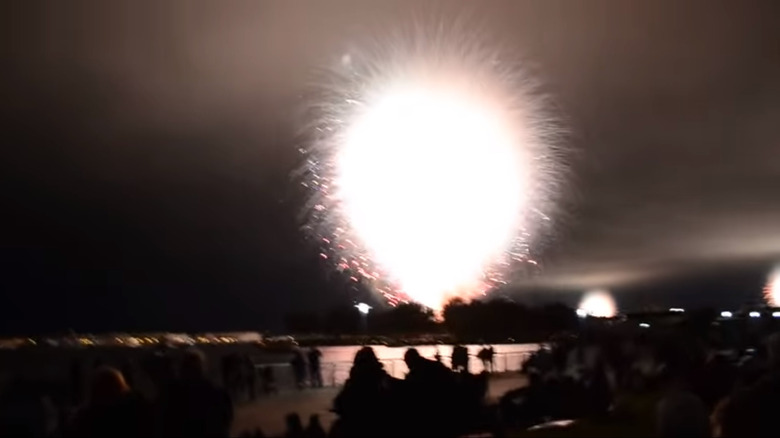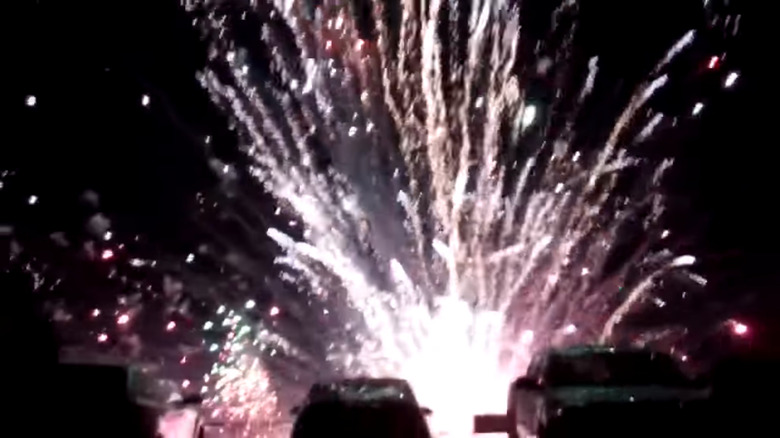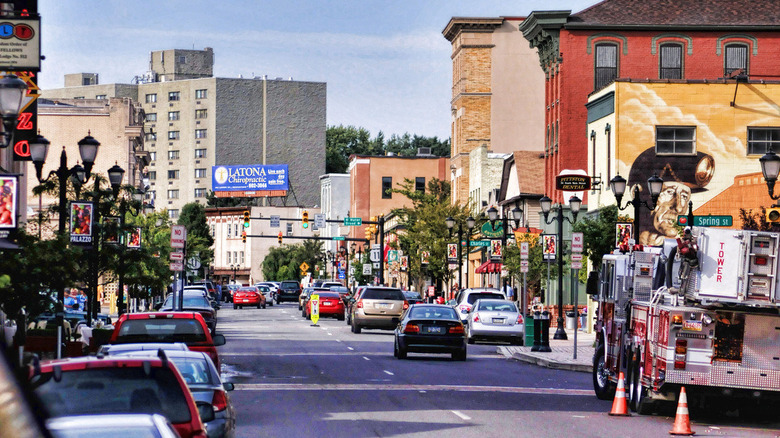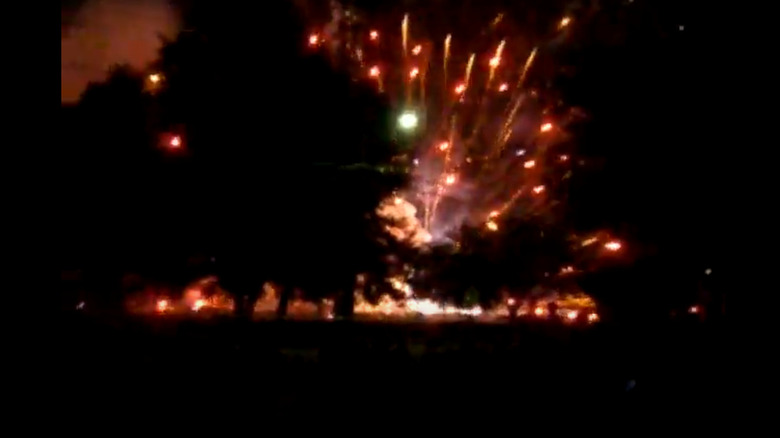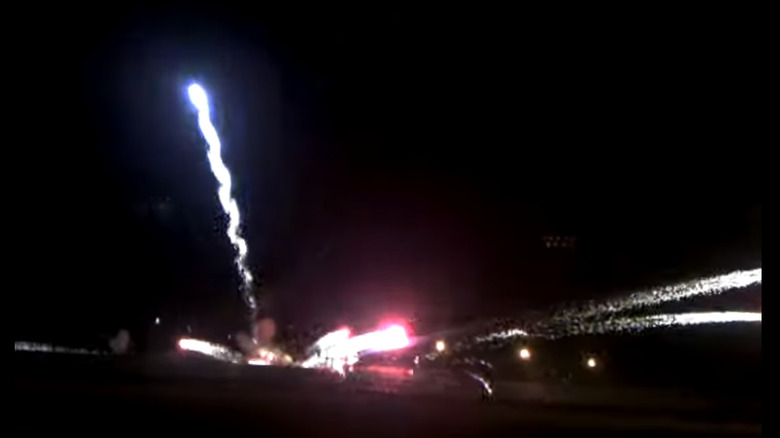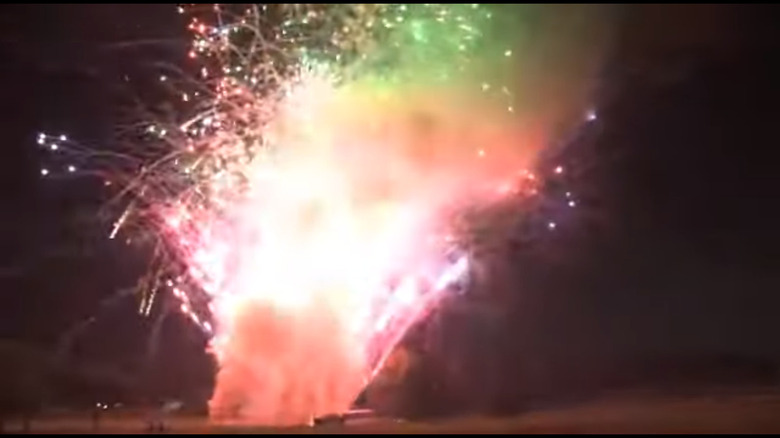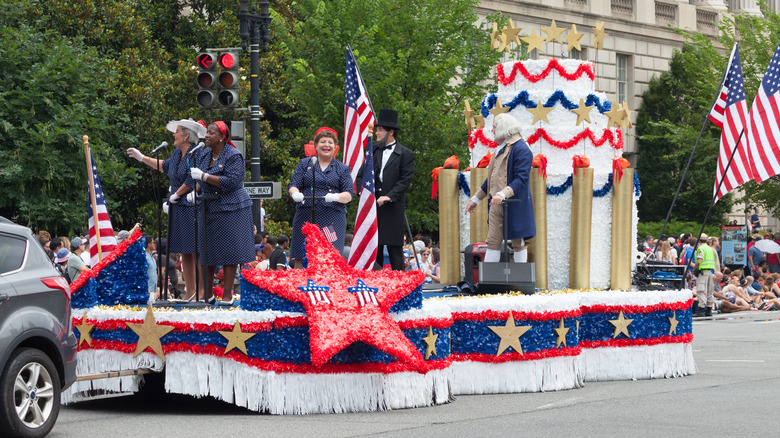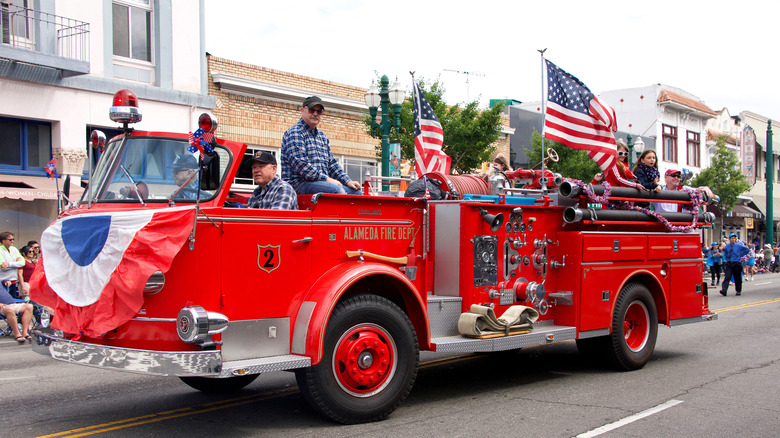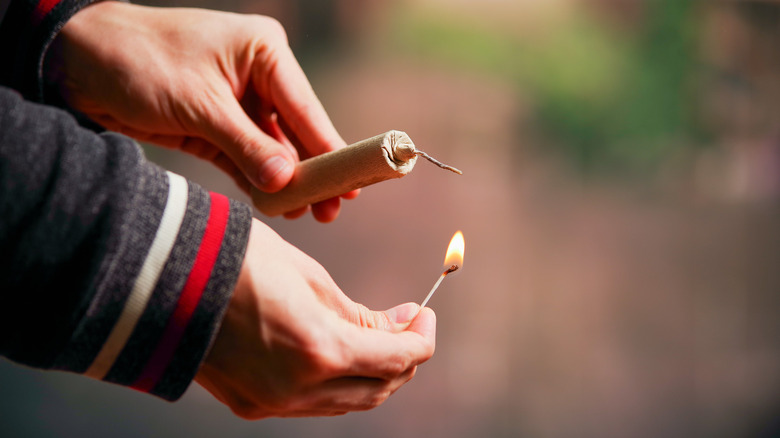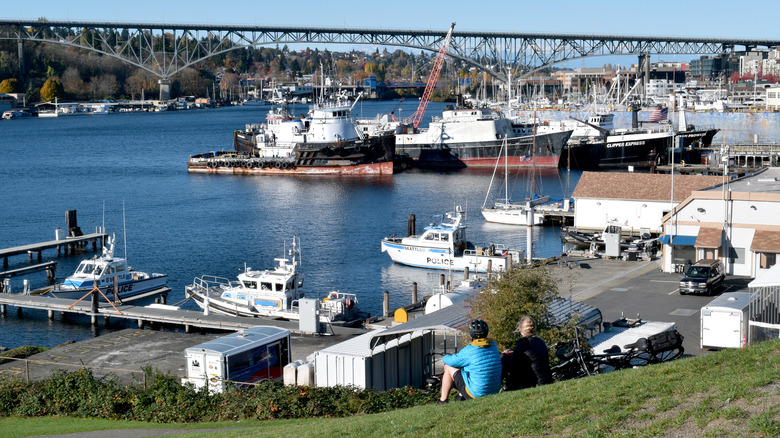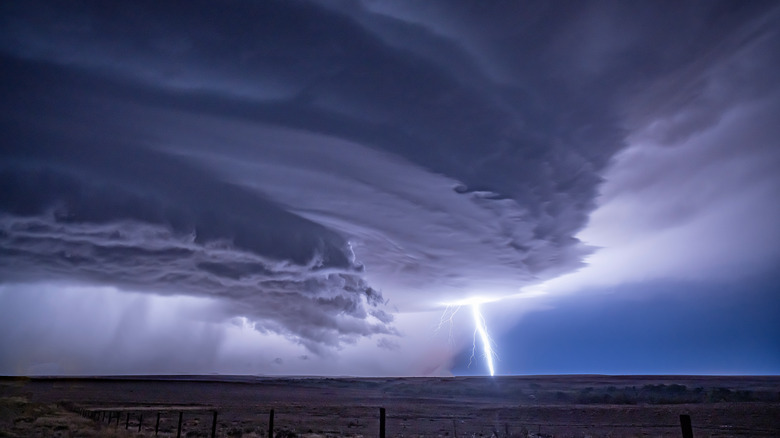Fourth Of July Celebrations That Went Terribly Wrong
Every year, the United States of America comes together for a few hours to celebrate the things that bind us all as one: Freedom, independence, and a shared love of blowing stuff up. The scourge of dogs everywhere, the Fourth of July is our national party, and Americans look forward to celebrating it every year. Fun fact: The oldest Fourth of July celebration is held in Bristol, Connecticut and dates back to 1785 — a full 85 years before the United States government made the Fourth into a Federal holiday. (It took another 70 years for government employees to get a paid day off for it.)
Sometimes, maybe we get a little too excited about it. Any time you get a large group of people together, there are risks, and those risks are often amplified on The Fourth. For one thing, people forget that fireworks are, you know, explosives. They're basically bombs with glitter packed into them, and mishandling them can lead to tragic results. And any large-scale celebration is going to be subject to wonky logistics, sudden shifts in weather, and other totally unpredictable events that can turn a pleasant day of patriotic cheering into a disaster.
Sometimes those disasters are hilarious. Sometimes they're soberingly tragic. Here are some Fourth of July celebrations that went terribly wrong.
The San Diego 2012 Spectacular Spectacular
People love fireworks. While setting off a few sparklers in your backyard is fun, a large, professionally-designed fireworks display always brings huge crowds, and many cities around the country take a lot of pride in their annual show. Back in 2012, however, the fireworks display put on by the city of San Diego went sideways in the most spectacular way.
As reported by The Atlantic, the city puts on its Big Bay Boom show every year, and pulls out all the stops with a fireworks show synced to music. The 2012 show was supposed to last close to 20 minutes, and Thrillest notes that it isn't exactly thrown together at the last minute: It takes several days to set everything up, and all the components of the fireworks are tested ahead of time to ensure a smooth and entertaining show. About half a million people head to various parks and other choice viewing sights to take in the extravaganza.
In 2012, though, everyone got a very different experience when a technical glitch caused all of the fireworks—every single one—to go off at the same time. The result was an 18-minute show compressed into about 15 seconds, sans music. The night sky was brighter than day during those 15 seconds, and opinion remains split as to whether this was the worst Fourth of July celebration ever—or the best.
The 2013 Simi Valley Disaster
As reminders that fireworks are basically bombs go, the 2013 Fourth of July celebration in Simi Valley, California does a pretty good job. As reported by The New York Daily News, close to 10,000 people crowded into a local park to watch a light show, with all of the fireworks set up on a wooden platform (whether or not wood is the correct choice of building material for explosive ordinance is a question for another day). Unfortunately, a portion of the wooden platform tipped over ... aiming the fireworks directly into the crowd.
CBS Los Angeles reports that the collapsed platform also seemed to cause the fireworks to start detonating out of control—and some attendees reported that they saw the fireworks crew fleeing the platform as the disaster unfolded—which might explain why the fireworks continued to go off for more than a minute after the platform collapse. The incident injured 28 people, 20 of whom had to go to the hospital. The show was obviously shut down and everyone was ordered to vacate the park as the bomb squad moved in to ensure the rest of the fireworks posed no threat.
This was a terrifying moment. Unsurprisingly, the Ventura County Star reports that multiple lawsuits were filed as a result.
The tragedy of Devon Staples
One of the biggest misconceptions surrounding Fourth of July celebrations is that fireworks are safe and harmless fun. Every year tens of thousands of fires and thousands of injuries are caused by fireworks. Sometimes these incidents are pure accidents, but sometimes they're caused by really poor decision-making—usually prompted by another common ingredient of Fourth of July celebrations: Alcohol.
Such was the case with Devon Staples. As The New York Daily News reports, Staples attended a party to celebrate the Fourth in 2015. Drinking alcohol and setting off fireworks, the group came across a mortar tube that appeared to be a dud: They lit it, but it didn't go off. Staples, goofing around and trying to make people laugh, either began swinging the mortar around his head or placed it on top of his head as a joke. The Washington Post reports that Staples' friends were horrified when he began playing with the mortar and tried to convince him to put it down. Tragically, the mortar exploded, killing Staples instantly.
His family believes he thought it was a "dud" and would never have played with a live firework. Worst of all, Staples was at the party with his fiancé—who he'd almost eloped with just a few days earlier. If he had gone through with the plan, the tragedy may never have happened.
A celebration of incompetence
When home-grown fireworks displays go awry, it's easy to judge those involved. They should have hired a professional to handle something as potentially dangerous as fireworks. But as the town of Pittston, Pennsylvania learned, hiring a professional isn't always a guarantee of a safe and enjoyable fireworks experience.
Firehouse reports that in 2004, a small crowd gathered at a local restaurant called Cooper's on the waterfront to watch the city's fireworks display. Everything went according to plan until the grand finale, when a specific firework failed to launch, instead exploding on the ground and sending its ordinance shooting into the crowd. HCPro reports that about 50 people were injured in the accident, with about 10 people severely burned—including several employees of the fireworks company. The explosion also started a fire in the restaurant itself. The area had to be cleared and all the fireworks scattered about had to be treated like unexploded bombs, with the local police working with the Bureau of Alcohol, Tobacco, Firearms and Explosives to investigate and ensure no one else was injured.
Torklaw reports that the company hired to put on the show, Schaefer Pyrotechnics, was found to be at fault and fined the surprisingly small amount of $8,100 by the U.S. Occupational Safety and Health Administration (OSHA) for safety violations. The company appealed and eventually settled for an even smaller $5,000 fine—but was later involved in several other incidents where their fireworks caused damage and injuries.
The illegal Chinese fireworks
Insidenova reports that Schaefer Pyrotechnics were hired to put on a display in Vienna, Virginia in 2007. Since this was the same company that caused a disaster at a 2004 fireworks show in Pennsylvania, it might not be surprising that the Vienna show did not go well. At all.
The company utilized a type of firework called a "cake box," imported from China. This firework contained 25 tubes with 3-inch-diameter mortars, for a total of 75 linked shells. As Torklaw notes, that means the cake box was also illegal under Virginia law, which prohibits chain-fusing more than 15 shells at once.
In the words of one official, the cake box "failed catastrophically" and fired into the crowd. A total of 11 people were injured, seven of whom had to be hospitalized—including five children. As noted by Business Insurance, a barrage of lawsuits against Schaefer Pyrotechnics followed, alleging nearly 20 distinct acts of negligence, including failure to follow correct hiring, training, and supervisory practices as well as a failure to obey all applicable laws. The company was eventually forced to pay out nearly $5 million in settlements, but continued to operate and to be hired to put on fireworks shows.
The power of a peanut
In 2010, the town of Palmyra, Pennsylvania hired Schaefer Pyrotechnics to produce a fireworks show for their Fourth of July celebration. The company had already been involved in at least two prior disasters, so the fact that they caused a third isn't really all that surprising, even if the fact that cities continued to hire them is. The Philadelphia Inquirer reports that one of the fireworks prepared for the show exploded prematurely, setting off a chain reaction that sent explosive material shooting off into the crowd and across the general area. A total of 11 people were injured as a result, including four children and the employee overseeing the show.
According to Torklaw, the malfunctioning firework was identified by the U.S. Occupational Safety and Health Administration (OSHA) (which investigated the incident) as a "peanut shell," so-called because it superficially resembles a large peanut. The peanut's premature explosion set off aerial fireworks that normally shoot high into the air, but which now shot directly at the crowd like rockets.
Despite the fact that this was at least the third show produced by Schaefer Pyrotechnics that ended in horror and the fact that OSHA issued several safety citations against the company (again), it only paid $4,712 in fines.
The humiliation of Coraville, Iowa
Back in the good old days, fireworks had to be set off by hand—a pretty dangerous business, considering fireworks are really just colorful bombs. But in the modern age computers have taken over the job of igniting fuses. This has not only made the work safer, it's also allowed for increasingly complex fireworks displays, because computers can manage much more complex patterns and incredibly precise timing.
Usually that timing involves starting relatively small and building to a dramatic, explosive ending. But as reported by The Gazette, in 2013 the city of Coraville, Iowa's fireworks display suffered a computer malfunction that caused it to go off much more quickly than programmed—and in reverse. About 75 percent of the show went off in the first minute, and then the show settled into a much more muted series of softer explosions. No one was injured, but according to WHO13 the city spends about $12,000 on the show every year, so this was an expensive mistake.
Although people insisted they still enjoyed the fireworks, the city's fire officials investigated the problem to make sure it didn't happen again.
The Black Parade
While most Fourth of July celebrations focus on fireworks, another common tradition is a parade through town. But according to The New York Times, in 2013, the parade staged by Edmond, Oklahoma to celebrate the Fourth ended in horrifying tragedy when an 8-year old boy was killed when he fell off a moving parade float.
The StarTribune reports that the parade is a big deal, the largest in the area with more than a hundred entries. It typically attracts thousands of people. The boy was riding on a martial arts-themed float in the parade. Even more tragically, the float was being driven by the boy's own father. When the boy climbed down off the float—or possibly fell—he was knocked over by a part of the float loaded with hay bales and fell over. His father could not see him in the street, and continued driving over the boy. Even worse, the incident was witnessed by many spectators, including a number of other children.
The tragic occurrence was ruled a tragic, freak accident, and no charges were brought against the boy's father or anyone else, as it was determined no safety rules were violated, and there was no way for the poor man to know what had happened as he operated the vehicle.
Shots fired in Bangor, Maine
It's not uncommon for people to fire their guns into the air in lieu of fireworks on the Fourth of July. But it's usually not advisable—and sometimes causes real problems. For example, a parade celebrating the Fourth was re-routed—but not canceled—when a local resident decided it was a good day to start firing his gun out the window in Bangor, Maine.
As The Bangor Daily News reports, a man named Perrin Oliver began firing his gun at random intervals starting at 8:30 in the morning. Since he sometimes fired indiscriminately out the window of his apartment, the local police created a perimeter and diverted foot and car traffic away from the area in order to avoid an accidental shooting.
Unfortunately, as noted by The StarTribune, this also meant the Fourth of July parade, which normally passed right by Oliver's window, had to be re-routed. Later a vintage fire truck collided with a vintage tractor, killing the driver of the tractor. Although some thought the sudden re-routing of the parade might have contributed to the accident, it was later determined the city had allowed the firetruck to participate without checking it brakes, which were faulty, and did not properly enforce spacing between the vehicles in the parade.
A spontaneous amputation in Chicago
It bears repeating: Fireworks are explosives. They are dangerous. It's a lesson that a woman named Kristina Perez learned the hard way in 2013.
As CBS Chicago reports, Perez and her sister-in-law went to a park on the southwest side of the city and sat together on the lawn. Not far away, a few men were setting off fireworks to celebrate the Fourth of July—with just one problem: They didn't have permission to do so. Suddenly one of the fireworks misfired and rocketed directly towards the two sisters-in-law, exploding directly in front of Perez. The explosion severed her left foot, and both sisters and seven others received serious burns as a result of the accident.
Naturally, as the Cook County Record reports, Perez attempted to sue over this turn of events, filing suits against the Chicago Park District, the city of Chicago, and Thomas Lagowski and Krzysztoff Gros, the two men who set off the fireworks. Later she amended to suit to list just the Park District as a defendant, claiming negligence. Perez argued that the park had hosted illegal fireworks for years, and since park staff cleaned up the debris every year they obviously knew it happened, yet they took no steps to stop it. Unfortunately for Perez, the courts decided the city had not sanctioned the fireworks, and thus could not be liable.
The Seattle boatyard disaster
When people decide to shoot off some fireworks they usually think it's a bit of harmless fun, but the improper handling of fireworks can cause a great deal of damage. In 2013, for example, The Seattle Times reports that a single errant firework caused about $1.5 million in damages at the North Lake Union boatyard.
The disaster occurred just before the city's official fireworks display was scheduled to begin. Many people were spotted setting off their own fireworks in anticipation, including some very large shells. According to KIRO 7 News, witnesses saw a single firework land in one of the boats, setting it instantly on fire when it exploded. An employee of a local company raced over, hoping to pull the burning boat away from the others, but arrived too late. He then attempted to use a fire extinguisher to put out the fire, but was unsuccessful.
The fire had spread to the next boat—and from there spread to 15 more. The fuel and fiberglass material of the boats helped the fire to spread very quickly. In just a few minutes, 14 boats were completely destroyed in the blaze, and several others were badly damaged.
The 1969 Cleveland Derecho
Sometimes disastrous Fourth of July celebrations have nothing to do with fireworks or human error at all. In 1969, for example, the people of Cleveland, Ohio suffered a horrifying Fourth due to some freakishly violent weather.
The Columbus Dispatch reports that July 4, 1969 was forecast to be hot and humid with a 40% chance of rain. That wasn't enough to discourage folks, who gathered around the area for cookouts and other celebrations. What hit them was "an apocalyptic storm" that drenched the area with 9 inches of rain in a 24-hour period, along with high winds. The resulting floods engulfed roads and bridges—and killed more than 40 people.
The government's Storm Prediction Center describes the freak weather event as a "derecho," which it defines as "a widespread, long-lived wind storm ... associated with bands of rapidly moving showers or thunderstorms." The 1969 Ohio Fireworks Derecho was one of the longest lines of storms ever seen up to that point according to the Akron Beacon Journal. Winds topped 100 mph, pulling down trees and power lines. The flood waters rose incredibly fast, and many people woke up in the middle of the night to find their homes flooded, and wound up on the roof. Boats capsized, and people had to literally run for their lives to escape the water. The damage was estimated at $100 million, which would be more than $700 million in today's money.

